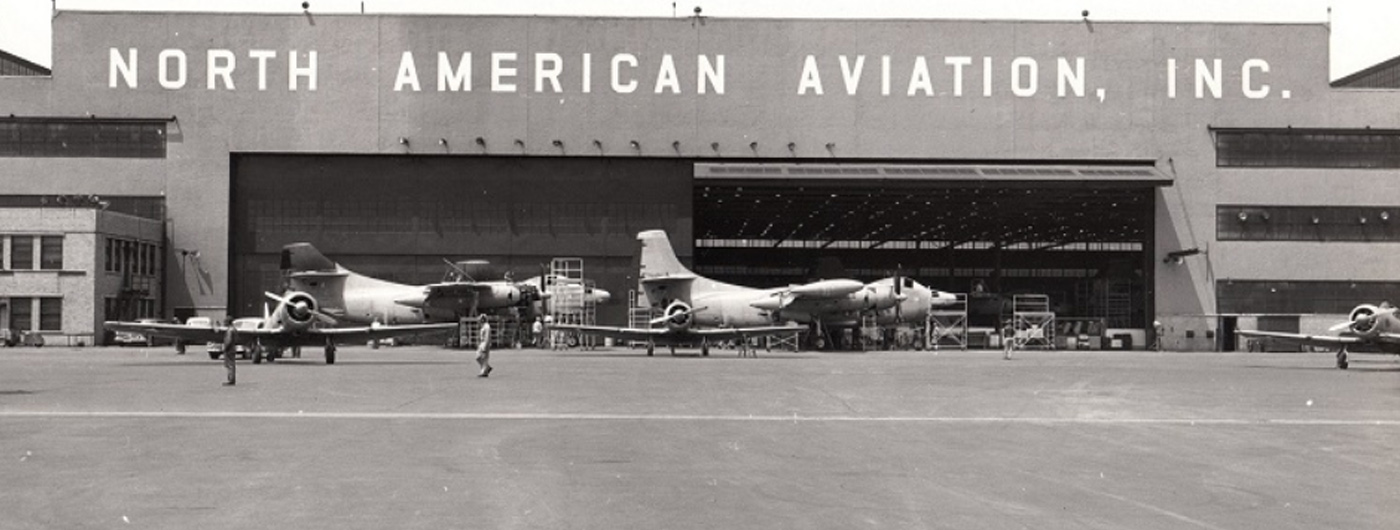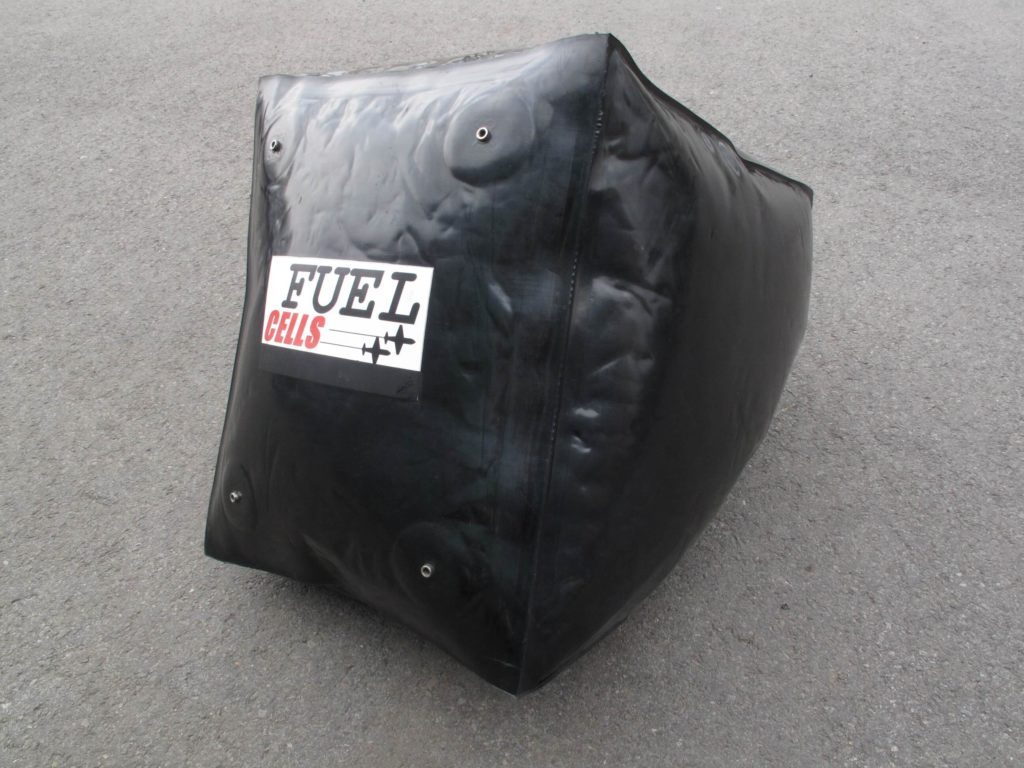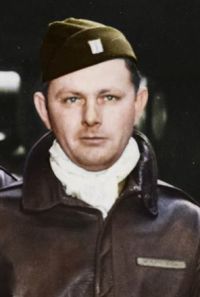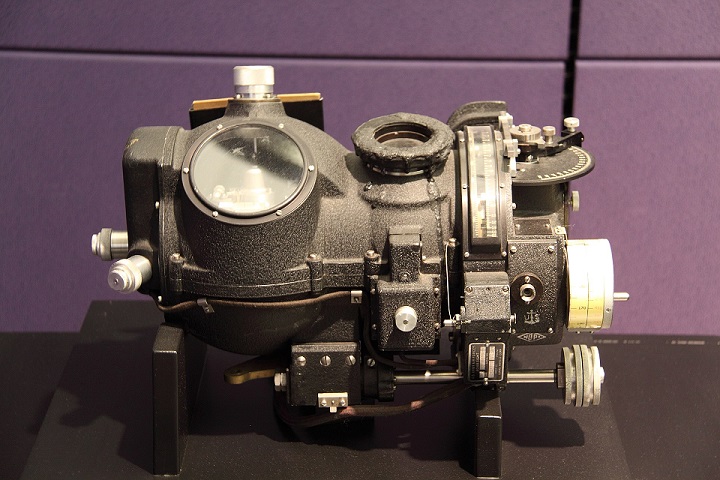Raider in the spotlight
Adjustments and modifications
The b-25 adjustments and modifications beefore the mission
The main adjustments
- Removal of the lower gun turret.
- Installation of de-icers and anti-icers.
- Mounting of steel blast plates on the fuselage around the upper turret.
- Removal of the liaison radio set to save weight.
- Installation of a collapsible neoprene auxiliary fuel tank, fixed to the top of the bomb bay, and installation of support mounts for additional fuel cells in the bomb bay, crawlway, and lower turret area, to increase fuel capacity from 646 to 1,141 U.S. gallons (538 to 950 imperial gallons, or 2,445 to 4,319 L).
- Installation of mock gun barrels (broomsticks) in the tail cone.
- Replacement of the Norden bombsight with a makeshift aiming sight devised by pilot C. Ross Greening pilot of Crew 11 that was dubbed the "Mark Twain" bombsight. The materials for this bombsight costed only 20 cents
Norden bombsight

Mark Twain bomb sight for bombing at low altitude
- Two bombers also had cameras mounted to record the results of the bombing.

Modifying the fuel tanks of selected B-25 bombers for the mission
After the attack on Pearl Harbor, people in the United States of America were willing to pay huge sums of money to individuals or groups of individuals who would retaliate against Japan or Tokyo in some way. So, the upper class of the population demanded or desired that the US retaliate.
The 24 claimed B-25 bombers were built by North American Aircraft Company. There was already technical understanding of these aircraft because before they were built, flight tests with test models had taken place in Louisiana and Carolina.

As mentioned, the B-25s were modified. In any case, it had to be ensured that there could be enough fuel to enable a longer flight distance. That was no sinecure. A steel and bulletproof tank would be installed in the bomb bay. A tank with a capacity of 1,003 liters (or 265 gallons). These were not available on the market, so they were ordered from the McQuary Company and installed in B-25s by Mid-Continent Airlines in Minneapolis, Minnesota.
However, later the tank would be replaced by rubber models made by the United States Rubber Company. Its capacity was 851 liters (or 225 gallons). The advantage of the rubber and bulletproof tank was that she could carry more contents. Air was blown into it so that the tank could carry up to 57 liters (or 15 gallons) extra. The tank took up less space and could be shaped or molded slightly more than a steel tank. In this way it was also possible to load more bombs in the bomber.
The disadvantage of the rubber tanks was that they sometimes leaked where the seams were joined. Before the mission started, the manufacturer provided an extra cover to put over it. There is an incident where a rubber bag almost completely tore. That was one day before takeoff from the USS Hornet during the mission. The rubber tank was repaired.

Another fuel bag with a capacity of 606 liters (or 160 gallons) was made by the same company. This was also built into the aircraft. There were leaks in the seams as well; a relatively common problem.
The gun turret under the aircraft was removed. A rubber bag with a capacity of 227 liters (or 60 gallons) was later also inserted there.
Then each plane was provided with ten five-gallon jerry cans (about 20 liters). These canisters were poured into the B-25's main tank during flight. They were stacked at the back of the plane near the radio operator's seat.
It is remarkable that when the jerry cans were emptied, the crew pecked holes in them and they were then thrown overboard into the sea. The holes pierced in the jerry cans caused seawater to run into the jerry cans and cause them to sink. They wanted to avoid at all costs that the enemies could follow the trail of empty jerry cans at sea in order to determine the escape route of the bombers. 16 x 10 jerry cans are 160 jerry cans that would otherwise float on the surface of the water and maybe expose the mission.

|
Wing tanks |
2,324 liter |
646 Gallons |
|
Bomb bay tank |
908 liter |
225 Gallons |
|
Center aisle tank |
605 liter |
160 Gallons |
|
Aft turret tank |
227 liter |
60 Gallons |
|
10 x 5 gallons jerrycans |
189 liter |
50 Gallons |
|
Total |
4,253 liter |
1,141 Gall |
|
Provided for every aircraft |
4.164 liter |
1.100 gallon |
The icers and anti-icers were also fitted to the aircraft. While they may not have been necessary in and over Tokyo and Japan because of the high enough temperature, they may have been needed over China.

Other modifications to the bombers
As said before, the aft gun turret would also be removed. But to deter attacking enemy aircraft from the rear of the aircraft, two brush handles/sticks with a diameter of 50 mm were made to resemble counterfeit machine guns. These protruded from the tail of the B-25s. The nose of the aircraft was equipped with a single 30 mm calibre machine gun.

The various (Bendix) turrets were removed from the aircraft for various reasons. One of them was that they didn't function properly and there were lots of problems with them. The manufacturer still had to make improvements, but there was no time to fix these before the mission. The aircraft was relatively new on the market and things like common children’s diseases still had to be cured. Because the turrets were removed, there was also more space in the aircraft.

All unnecessary combustible materials were removed from the bombers to prevent unwanted fire in the event of an enemy bullet hit, for example. The radio installation in the aircraft, which weighed 105 kg (or 230 pounds), was removed from the aircraft. This was done to keep radio silence during the mission, but also not to have to drag excess weight along. Knives, pistols, cans, etc. were supplied. A small bottle of whiskey was also arranged for each crew member. Incendiary bombs and other bombs were provided for the bombers. Maps and photographs of the targets were also provided in the aircraft. However, most of the training time was spent modifying the B-25 bombers.

The Heroes of Doolittle's raid on Japan in april 1942
by Mr. Geert Rottiers
The book will be available soon.


